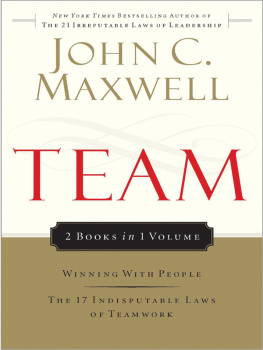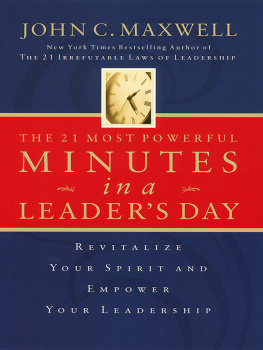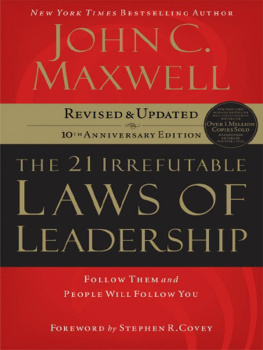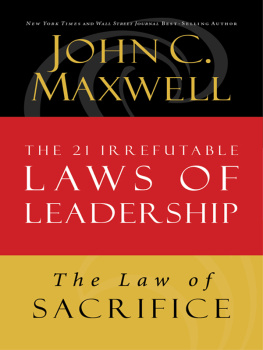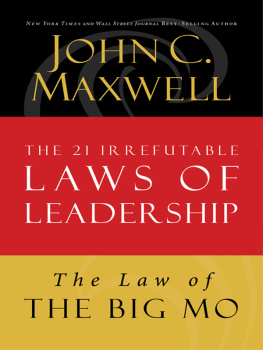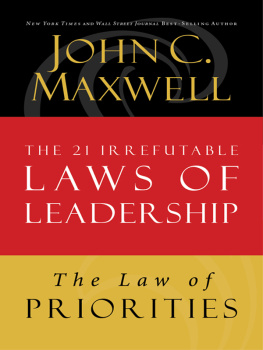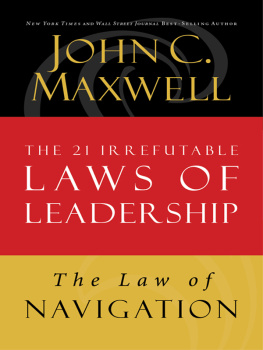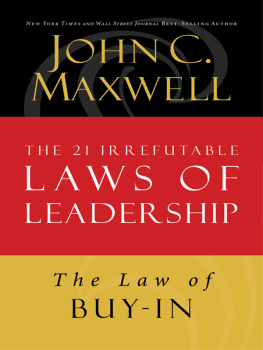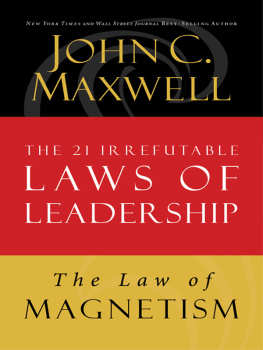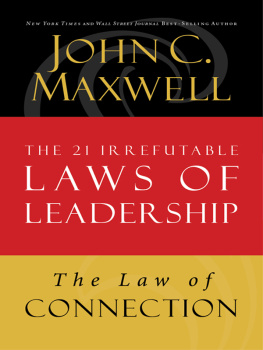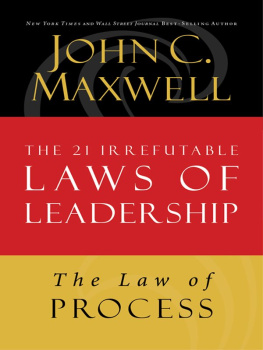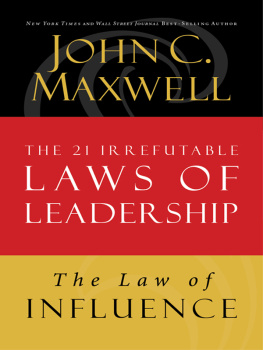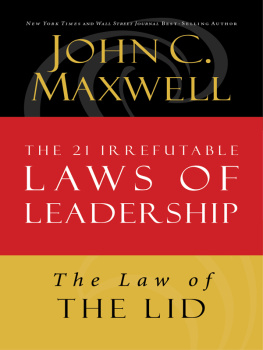
1998 and 2007 by John C. Maxwell
This ebook is derived from The 21 Irrefutable Laws of Leadership, by John Maxwell, 1998 and 2007 by Maxwell Motivation, Inc., a Georgia corporation.
All rights reserved. No portion of this book may be reproduced, stored in a retrieval system, or transmitted in any form or by any meanselectronic, mechanical, photocopy, recording, scanning, or otherexcept for brief quotations in critical reviews or articles, without the prior written permission of the publisher.
Published in Nashville, Tennessee, by Thomas Nelson. Thomas Nelson is a trademark of Thomas Nelson, Inc.
Thomas Nelson, Inc. titles may be purchased in bulk for educational, business, fund-raising, or sales promotional use. For information, please e-mail SpecialMarkets@ThomasNelson.com.
Published in association with Yates & Yates, LLP, Attorneys and Counselors, Orange, California.
Scripture quotations noted CEV are from THE CONTEMPORARY ENGLISH VERSION.
1991 by the American Bible Society. Used by permission.
Scripture quotations noted The Message are from The Message: The New Testament in Contemporary English. 1993 by Eugene H. Peterson.
ISBN 978-0-7852-7431-5 (HC)
ISBN 978-1-4185-3831-6 (ebook)
ISBN 978-1-4002-7578-6 (ebook of Chapter 19)

This book is dedicated to Charlie Wetzel, my writing partner since 1994. Together weve written more than forty books, and Ive enjoyed our collaboration on every one. As I have labored to add value to others by identifying and teaching leadership principles, Charlie, you have added value to me and my efforts. Your insights and skills as a wordsmith have been enjoyed by millions of readers. As a result, you have made a greater impact on more people than has anyone else in my inner circle. For that I thank you.
CONTENTS


Thank you to the thousands of leaders around the world who learned and sometimes challenged the laws of leadership, thus sharpening my thinking.
Thank you to the team at Thomas Nelson who gave me the chance to revise and improve this book, and especially to Tami Heim for her strategic leadership and to Victor Oliver who was instrumental in the development of the original concept.
Thank you to Linda Eggers, my executive assistant, and her assistant, Sue Caldwell, for their incredible service and willingness to go the extra mile every day.
Thank you to Charlie Wetzel, my writer, and Stephanie, his wife, with-out whose work this book would not have been possible.

When to Lead Is As Important As
What to Do and Where to Go
If ever there was an example of the importance of timing as it relates to leadership, it came in New Orleans in late August and early September of 2005.
New Orleans is an unusual city. Like Venice, Italy, it is surrounded by water. To the north lies Lake Pontchartrain. To the south flows the mighty Mississippi River. To the east and west are low-lying swamplands. Canals crisscross the city. You cannot drive into or out of New Orleans without crossing a major bridge. That may not seem like a big dealuntil you consider that most of the city lies below sea level. New Orleans is shaped like a bowl. On average, the city is six feet below sea level. In the lowest areas, its nine feet below sea level. And the land in New Orleans sinks a little more every year. For decades citizens have worried about the potential damage that a direct hit from a powerful hurricane could do to the city.
DISASTER ON THE HORIZON
On Wednesday, August 24, 2005, nobody in New Orleans could have known that the newly formed tropical storm, named Katrina, would be the big onethe hurricane the city had feared would someday come. It wasnt until Friday that the National Hurricane Center predicted that the storm would reach landfall on Monday somewhere near Buras, Louisiana, about sixty miles southeast of New Orleans. The hurricane was already looking like a bad one. The next morning, Saturday, August 27, the leaders of many of Louisianas parishes around New Orleans ordered mandatory evacuations: St. Charles, Plaquemines, parts of Jefferson, and even St. Tammany, which is situated on higher ground north of New Orleans.
But what about New Orleans? Why didnt Mayor Ray Nagin, the leader of the city, order a mandatory evacuation at the same time? Many people say New Orleanians are fatalistic and they cant be made to move any faster than they want to go. Others say that Nagin, a businessman before he was elected, was worried about the legal and financial implications of an evacuation. I say he and others in government didnt understand the Law of Timing. When to lead is as important as what to do and where to go.
The time to move people out of New Orleans was when the other parish leaders announced their mandatory evacuations. Nagin waited. On Saturday evening he finally announced a voluntary evacuation of New Orleansonly after Max Mayfield, the director of the National Hurricane Center, called Nagin on Saturday night did the mayor become concerned enough to act. Max scared the crap out of me, Nagin is reported to have said after the call.
TOO LITTLE TOO LATE
The next morning at nine oclock, Nagin finally ordered a mandatory evacuationfewer than twenty-four hours before the hurricane would make landfall. It was much too late for many citizens of New Orleans. And how did he plan to help those people who couldnt make it out of town on such short notice? He advised them to get to the Superdome, the citys shelter of last resort, however they could. But he made no real provisions for them. In a press conference Nagin advised:
If you cant leave the city and you have to come to the Superdome, come with enough food, [non]perishable items to last for three to five days. Come with blankets, with pillows. No weapons, no alcohol, no drugs. You know, this is like the governor said, youre going on a camping trip. If you dont know what thats like, just bring enough stuff for you to be able to sleep and be comfortable. Its not going to be the best environment, but at least you will be safe.
The results of Nagins leadership played out in the national coverage of Katrina and its aftermath. Water was flowing into parts of the city by nine oclock Monday morning. Conditions for the people at the Superdome were dreadful. Other people who couldnt get out of town flocked to the Convention Center. Many citizens were stranded on rooftops. How did Nagin respond? He complained to the media at press conferences.
ANOTHER CHANCE
If someone was going to step in and lead, it would have to occur somewhere other than the local level. Most people began looking to the federal government for leadership, but they violated the Law of Timing, too. Not until Wednesday, August 31, did Director of Homeland Security Michael Chertoff release a memo declaring Katrina an Incident of National Significancea key designation needed to trigger swift federal coordination. Finally, on Sunday, September 4six days after New Orleans floodedthe evacuation of the Superdome was finally complete.
Next page


